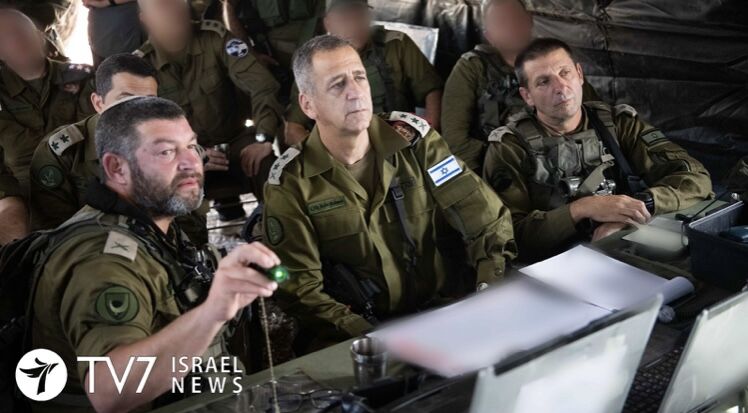Kochavi’s Cohorts’ relentless rehearsal
By Amir Oren
In the 1981 movie “Chariots of Fire”, the leading role belongs to the winner of the 100-meter dash in the 1924 Paris Okympics, representing Great Brirain. Harold Abrahams stood out by being Jewish, rare for athletes at the time, for reasons of upbringing and discrimination.
Perhaps the excellent drama, released in Israel just as teen-ager Aviv Kochavi was about to graduate from high-school and enlist in the Paratroops, made a lasting impression on the 22nd Chief of General Staff of the Israel Defense Forces. In some seven months Lt.-Gen. Kochavi will hand over the military to his successor, virtually certainly his deputy, Maj.-Gen. Herzi Halevi, and to distill his term in office into one final big event he presided over Exercise Chariots Of Fire, held throughout the country – with a detour to Cyprus – for the last month.
While an appealing psychological explanation, there is a much more probable reason for Kochavi’s Operations Officer, Brig.-Gen. Yaron Finkelman, suggesting the name to his Chief: it cleverly combines the two essential elements of Israel’s military doctrine, to be employed either simultaneously or successively in war or major campaigns.
Israel’s most potent power has been intelligence-rich aerial strike. Air Force Fighters, Helicopters and drones, bolstered by missiles launched from ground and sea and long-range artillery of both the gun and rocket varieties. These are all stand-off weapons and munitions, intended for precision hits across the border.
Over the last couple of decades, Israel has been a world-leading integrator of several technological disciplines with military applications. Its officers and thinkers realized that separate stovepipes will not do in the information age. Intelligence, computers, command-and-control, operational planning, real-time targeting – they were all skilfully thrown into the melting pot, out of which came masterfully executed Air Plans, but much less so ground forces schemes.
Loud protests by a generation of military leaders notwithstanding, the Fire part of IDF doctrine and practice was more convincing than the declared determination to employ Chariots, Israel’s home-made Merkava tanks. Sincere intentions somehow were never translated into battlefield action. Tanks were ominously deployed near the front, or even a few kilometers inside Hezbollah or Hamas lines, but this was not what the founders of the IDF’s Airland Battle doctrine (to use the title copied by the US Army following lessons learned in the Yom Kippur War) had in mind. No armoured fornations, no tank-infantry-artillery-engineer combat teams launched into battle.
The problem is three-fold, the impact on Israeli society, servicemen and adversaries. Israel is casualty-averse. The less manpower-intensive fight, the better. An F-16 Squadron is preferable to a Chariot&APC’s Battalion, and if a UAV can do a manned platform’s job without a pilot risking his – or increasingly, her – life or liberty, that would be fine with the citizenry, also known as the voters.
Not so their eager offspring. 18-year-olds who want to see combat compete for precious few slots in elite units – Special Forces in all three branches and tip-of-the-spear infantry. Even the once lowly Border Patrol now attracts highly notivated youth, because in the West Bank and East Jerusalem police action means, well, action. Tanks are important, inductees keep hearing from recruiters, but their common sense tells them that they will be kept in reserve.
Kohavi was faced by pressure from two sides, with the more mundane black-boot units in the middle. Conscripts are opting for either the prestigious Commando-type forces or for High-tech organizations (such as the Intelligence Corps’ Unit 8200) paving their way to rewarding civil-sector jobs following their three-year or slightly longer commitment. National security is indeed increasingly dependent on such technologies and the talents invested in them, acknowledged Kochavi, himself an innovative former Intelligence Chief, but “Cyber Warrior” is a misnomer – warriors are only those who put their lives on the line and should be held in the highest regard by their compatriots.
As for the nation’s foes, in the half-dozen fronts facing the military (in conjunction with SHABAK, Mossad and police activities), the idea is to impress upon them that Kochavi’s cohorts will not be detered from marching deep into Lebanese, Syrian or Palestinian territory. In addition, heavier forces are obviously training in defensive scenarios, to repel invaders along – or under – the Galillee, Golan or Gaza boundaries. The exercise tested the ability of headquarters and communication nodes to respond immediately and effectively to surprise attacks. Good for muscle memory in commands and staffs, less so for soldiers’ individual skills, as they serve out their conscription and are only partly assigned to second-line reserve unit.
And the there is Iran. The IDF emphasised that part of the story-line dealing with Israel’s Persian nemesis – long range Air Force strikes, Commandos in unknown terrain (both in Cyprus), Naval units (Missile boats and submarines) in the Red Sea, a relatively short hop to within range of Iran. While the Israel Navy is publicly renewing its Landing Craft flotilla, it does not seem plausible that these vessels will soon be used to transport tanks to Tehran via a D-Day style beachhead operation. If an Iran contingency is operationalised, there will be more Fire than Chariots. Or is that what the Revolutionary Guards are led to believe, just to be caught off-guard? More to come.
